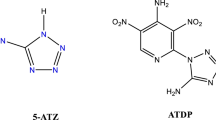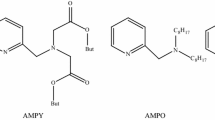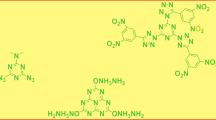Abstract
There were 10 nitrogen-rich energetic compounds prepared by the reaction of 2,4,6-trinitrochlorobenzen (picryl chloride) with pyrazole, 1,2,4-triazole, imidazole, 3-aminopyrazole, 3-nitropyrazole, 3-amino-1,2,4-triazole, 3-nitro-1,2,4-triazole, 3,5-diamino-1,2,4-triazole and guanidine. These compounds were characterized with IR spectra, elemental analysis and 1H NMR and 13C NMR methods. They were also examined with thermogravimetry and differential thermal analyses. The heat generated after the explosion was measured by the use of differential scanning calorimetry. The formation enthalpies of some of the products synthesized were determined by the use of Gaussian 09 software, and probable products were estimated from the data reported in the literature. Finally, theoretical explosion energies of these compounds were calculated using the theoretical formation enthalpies and compared with experimental data.


















Similar content being viewed by others
References
Klapötke TM. Chemsitry of high-energy materials. Berlin: Walter de Gruyter; 2012. p. 141–64.
Agrawal JP, Hodgson RD. Organic chemistry of explosives. Chichester: Wiley; 2007. p. 158–9.
Talawar MB, Sivabalan R, Mukundan T, Muthurajam H, Sikder AK, Gandhe BR, Rao AS. Environmantally compatible next generation green energetic materials. J Hazard Mater. 2009;161:589–607.
Badgujar DM, Talawar MB, Asthana SN, Mahulikar PP. Advances in science and technology of modern energetic materials: an overview. J Hazard Mater. 2008;151:289–305.
Politzer P, Murray JS. Energetic Materials Part 1. Decomposition, crystal and molecular properties. Elsevier: 2003. pp 411–416.
Shaw RW, Bril TB, Thompson DL. Overview of recent research on energetic materials. Singapore: World Scientific; 2005. p. 474–85.
Klapötke TM. Chemsitry of high-energy materials. Berlin: Walter de Gruyter; 2012. p. 141–2.
Agrawal JP, Surve RN, Sonawane SH. Some aromatic nitrate esters: synthesis, structural aspects, thermal and explosive properties. J Hazard Mater. 2000;77:11–31.
Agrawal JP, Hodgson RD. Organic chemistry of explosives. Chichester: Wiley; 2007. p. 158–62.
Badgujar DM, Talawar MB, Harlapur SF, Asthana SN, Mahulikar PP. Synthesis, characterization and evaluation of 1,2-bis(2,4,6-trinitrophenyl)hydrazine. J Hazard Mater. 2009;172:276–9.
Zeng Z, Guo Y, Twamley B, Shreeve JM. Energetic polyazole polynitrobenzenes and their coordination complexes. Chem Commun. 2009;6014–6. doi:10.1039/b915090k.
Agrawal JP. Past, present and future of thermally stable explosives. Cent Eur J Energ Mater. 2013;9:273–90.
Agrawal JP, Hodgson RD. Organic chemistry of explosives. Chichester: Wiley; 2007. p. 166.
Loule JA, Mills K. Heterocyclic Chemistry. 5th ed. New York: Wiley; 2010. p. 557.
Jameson DL, Goldsby KA. 2,6-Bis(pyrazolyl)pyridines. J Org Chem. 1990;55:4992–4.
Lee J, Block-Bolton A. Correlation of physical and chemical properties of c-h-n-o explosives (part II). Propellants, Explos, Pyrotech. 1993;18:161–7.
Agrawal JP. High energy materials. Weinheim: Wiley; 2010. p. 93–5.
Coburn MD, Jackson TE. Picrylamino-substituted heterocycles, III. 1,2,4-triazoles. J Heterocycl Chem. 1968;5:199–203.
Gaussian 09. Revision B.01. 2009.
Politzer P, Lane P, Concha MC. Computational determination of nitroaromatic solid phase heats of formation. Struct Chem. 2004;15:469–78.
Byrd EFC, Rice BM. Improved prediction of heats of formation of energetic materials using quantum mechanical calculations. J Phys Chem A. 2006;110:1005–13.
Özkaramete E, Şenocak N, İnal EK, Öz S, Svoboda I, Atakol O. Experimental and computational studies on the thermal degradation of nitroazidobenzenes. Propellants, Explos, Pyrotech. 2013;38:113–9.
Şen N, Özkaramete E, Yılmaz N, Öz S, Svoboda IM, Akay A, Atakol O. Thermal decomposition of dinitro-chloro-azido benzenes: a comparison of theoretical and experimental results. J Energ Mater. 2014;32:1–15.
Klapötke TM. Chemsitry of high-energy materials. Berlin: Walter de Gruyter; 2012. p. 75–9.
Becke AD. Correlation energy of an inhomogeneous electron gas: A coordinate-space model. J Chem Phys. 1988;88:1053–62.
Wilson AK, Van Mourik T, Dunning TH. Gaussian basis sets for use in correlated molecular calculations. VI. Sextuple zeta correlation consistent basis sets for boron through neon. J Mol Struct. 1996;388:339–49.
Politzer P, Lane P, Concha MC. Determination of nitroaromatic solid phase heats of formation. Struct Chem. 2004;15:468–79.
Gökçınar E, Klapötke TM, Bellamy AJ. Computational study on 2,6-diamino-3,5-dinitropyrazine and its 1-oxide and 1,4-dioxide derivatives. J Mol Struct THEOCHEM. 2010;953:18–23.
Akhavan J. The chemistry of explosives (RSC paperbacs). Cambridge: The Royal Society of Chem; 1998. p. 1–11.
Bailey AS, Case JR. 4:6-dinitrobenzofuroxan, nitrobenzodifuroxan and benzotrifuroxan: a new series of complex-forming reagents for aromatic hydrocarbons. Tetrahedron. 1958;3:113–31.
Reddy GO, Murall BKM, Chotterjee AK. Thermal study on picryl azide (2-azido-1,3,5-trinitrobenzene) decomposition using simultaneous thermogravimetry and differential scanning calorimetry. Propellants, Explos, Pyrotech. 1983;8:29–33.
Shremetev AB, Aleksandrova NS, Ignat NV, Schulte M. Straightforward one-pot synthesis of benzofuroxans from o-halonitrobenzenes in Ionic liquids. Mendeleev Commun. 2012;22:95–7.
Cardillo P, Gigante L, Lunghi A, Zanirato P. Revisiting the thermal decomposition of five ortho-substituted phenyl azides by calorimetric technics. J Therm Anal Calorim. 2010;100:191–8.
Fu XL, Fan XZ, Wang BZ, Huo H, Li JZ, Hu RZ. Thermal behavior, decomposition mechanism and thermal safety of 5,7-diamino-4,6-dinitrobenzofuroxan (CL-14). J Therm Anal Calorim. 2016;124:993–1001.
Standard Reference Database Number 69. National Institute of Standards and Technology. Gaitherburg, http://webbook.nist.gov/chemistry. Accessed 20 Dec 2013.
Keshavarz MH. Predicting condensed phase heat of formation of nitroaromatic compounds. J Hazard Mater. 2009;169:890–900.
Keshavarz MH. Predicting condensed phase heat of formation of energetic compounds. J Hazard Mater. 2011;190:330–44.
Tang Y, Yang H, Hu X, Huang H, Lu C, Cheng G. A novel N–N bond cleavage in 1,5-diaminotetrazole. J MatER Chem A. 2014;2:4127–31.
Xiaohong L, Qingdong C, Xianzhou Z. Density functional theory study of several nitrotriazole derivatives. J Energ Mater. 2010;28:251–72.
Shoaib MA, Cho SG, Choi CH. Fast and accurate prediction of heat of formation by G4MP2-SFM parameterization scheme. Chem Phys Lett. 2014;599:57–62.
Atkins P, Paula JD. Atkin’s physical chemistry. 8th ed. Oxford: Oxford University Press; 2006. p. 45.
Kubota N. Propellants and explosives, thermochemical and aspects of combustion. Weinheim: Wiley; 2007. p. 23–39.
Agrawal JP. High energy materials. Weinheim: Wiley; 2010. p. 1–33.
Author information
Authors and Affiliations
Corresponding author
Rights and permissions
About this article
Cite this article
Yigiter, A.O., Atakol, M.K., Levent Aksu, M. et al. Thermal characterization and theoretical and experimental comparison of picryl chloride derivatives of heterocyclic energetic compounds. J Therm Anal Calorim 127, 2199–2213 (2017). https://doi.org/10.1007/s10973-016-5766-2
Received:
Accepted:
Published:
Issue Date:
DOI: https://doi.org/10.1007/s10973-016-5766-2




